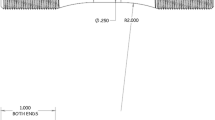Abstract
The low cycle fatigue behavior of three wrought nickel-base alloys, alloy 901, Waspaloy and alloy 718, has been examined at both room temperature and 811 K (1000°F). The fatigue properties can be rationalized in terms of the Manson-Coffin equation relating total strain range with the number of cycles to failure. For a given total strain range the fatigue life of the alloys at 811 K (1000°F) is substantially less than at room temperature. Microstructural examination revealed that crack nucleation and initial propagation was of classical stage I type. The cracks develop at the surface of test specimens and propagate along slip planes. Evidence is presented to relate the observed fatigue softening with shear and dissolution of γ precipitates.
Similar content being viewed by others
References
C. H. Wells and C. P. Sullivan:Tram. ASM, 1964, vol. 67, p. 841.
C. H. Wells and C. P. Sullivan:Trans. ASM, 1965, vol. 58, p. 391.
C. H. Wells and C. P. Sullivan:Trans. ASM, 1967, vol. 60, p. 217.
C. H. Wells and C. P. Sullivan:Trans. ASM, 1968, vol. 61, p. 149.
M. Gell and G. R. Leverant:Trans. TMS-AIME, 1968, vol. 242, p. 1869.
G. R. Leverant and M. Gell:Trans. TMS-AIME, 1969, vol. 245, p. 1167.
M. Gell, G. R. Leverant, and C. H. Wells:Achievement of High Fatigue Resistance in Metals and Alloys, p. 113, ASTM STP 467, 1970.
L. F. Coffin, Jr.:Thermal and High-Strain Fatigue, Monograph and Report Series No. 32, p. 171, The Metals and Metallurgy Trust, 1967.
T. Endo and J. Morrow:J. Mater., 1969, vol. 4, p. 159.
C. H. Wells:Acta Met, 1969, vol. 17, p. 443.
L. F. Coffin, Jr.:J. Mater., 1971, vol. 6, p. 388.
T. Broom, J. A. Mazza, and V. N. Whittaker:J. Inst. Metals, 1957-58, vol. 86, p. 17.
J.B. Clark and A. J. McEvily:Acta Met., 1964, vol. 12, p. 81.
C. Laird and G. Thomas:Int. J. Fract. Mech., 1967, vol. 3, p. 81.
J. T. McGrath and W. J. Bratina:Phil Mag., 1965, vol. 12, p. 1293.
D. V. Wilson and J. K. Tromans:Acta Met, 1970, vol. 18, p. 1197.
C. E. Feltner and P. Beardmore:Achievement of High Fatigue Resistance in Metals and Alloys, p. 77, ASTM STP 467,1970.
Author information
Authors and Affiliations
Rights and permissions
About this article
Cite this article
Merrick, H.F. The low cycle fatigue of three wrought nickel-base alloys. Metall Trans 5, 891–897 (1974). https://doi.org/10.1007/BF02643144
Received:
Published:
Issue Date:
DOI: https://doi.org/10.1007/BF02643144




